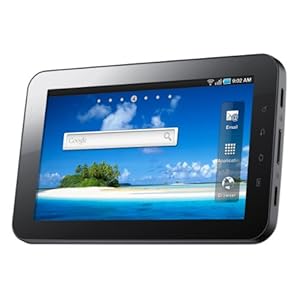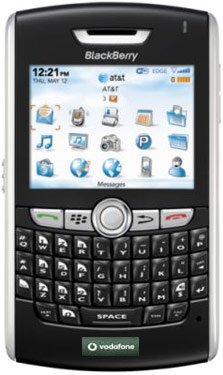Samsung's Galaxy Tab is being touted as the most promised rival to Apple iPad. The tablet is powered by Android Froyo, the latest version of Google’s operating software for mobile devices. Here is the review of the tablet:
1) Display Screen
Samsung Galaxy Tab has smaller screen size than iPad. It is about as tall and wide as Amazon.com Inc's newest Kindle e-reader. The tablet's 7-inch backlit color touch screen is less than half the size of the iPad display.
2) Lighter than iPad but rugged
It is also much lighter - almost 14 ounces versus about 24 for the iPad - and a smidgeon thinner. Still, it feels solid and seems rugged enough to stand up to heavy use. For instance, the front is protected by a sheet of Corning Inc’s Gorilla Glass, which ought to provide ample protection from any set of keys you might toss into the same pocket.
3) Replica of a Bigger Smartphone
Using an iPad isn’t like using an iPod Touch. It is larger size and two-hand operation makes it a very different experience. By contrast, using the Galaxy Tab is a lot like using one of the big-screen Android-based smartphones, such as Motorola Inc’s Droid X or HTC Corp's EVO.
4) Same processor as Samsung Galaxy S phone
The Galaxy, which is powered by the same processor used in Samsung’s Galaxy S smartphones, comes with 16GB of onboard storage for apps and content, the same as the base-level iPad. A slot for an SD memory card lets you expand it by an additional 32GB. The cameras are nothing special - the front facing one is 1.3 megapixels, the rear is 3 megapixels - but it’s kind of fun to be able to see your photo or video on the 7-inch screen while you’re shooting it.
5) Missing AMOLED
The screen on the Galaxy can be a disappointment. It is bright enough but lacks the jump-out-at-you pizzazz of the gorgeous Super AMOLED displays that Samsung uses on the Galaxy S phones. The screen also displays an annoying tendency to dim itself while you are using it, the result of a feature that analyzes the image being displayed and automatically adjusts the brightness.
Even with the option disabled, the screen would sometimes dim on its own, though not as often.
6) Lesser Apps than iPad
Samsung has tailored some of the tablet’s included software, such as the e-mail client and calendar, to take advantage of the larger-than-a-phone screen. Still, very limited third party apps are available that have been adapted to its dimensions and capabilities.
7) Non-replaceable battery
Like the iPad’s, the Galaxy Tab’s battery is not user-replaceable. Samsung says the Galaxy has a battery life of six to seven hours of continuous video playback, which is less than the iPad but sufficient to keep you entertained on a cross-country flight. Warning: On two separate devices, the charge plunged when Bluetooth connectivity was enabled, so keep it off unless you need it.
8) Expensive
You might be willing to live with the Galaxy Tab’s compromises if you were at least saving a bunch of money over an iPad. But, apparently it doesn't promise that at the moment.
Have you used Samsung Galaxy Tab? Share your experience in comments section.
Read rest of entry
1) Display Screen
Samsung Galaxy Tab has smaller screen size than iPad. It is about as tall and wide as Amazon.com Inc's newest Kindle e-reader. The tablet's 7-inch backlit color touch screen is less than half the size of the iPad display.
2) Lighter than iPad but rugged
It is also much lighter - almost 14 ounces versus about 24 for the iPad - and a smidgeon thinner. Still, it feels solid and seems rugged enough to stand up to heavy use. For instance, the front is protected by a sheet of Corning Inc’s Gorilla Glass, which ought to provide ample protection from any set of keys you might toss into the same pocket.
3) Replica of a Bigger Smartphone
Using an iPad isn’t like using an iPod Touch. It is larger size and two-hand operation makes it a very different experience. By contrast, using the Galaxy Tab is a lot like using one of the big-screen Android-based smartphones, such as Motorola Inc’s Droid X or HTC Corp's EVO.
4) Same processor as Samsung Galaxy S phone
The Galaxy, which is powered by the same processor used in Samsung’s Galaxy S smartphones, comes with 16GB of onboard storage for apps and content, the same as the base-level iPad. A slot for an SD memory card lets you expand it by an additional 32GB. The cameras are nothing special - the front facing one is 1.3 megapixels, the rear is 3 megapixels - but it’s kind of fun to be able to see your photo or video on the 7-inch screen while you’re shooting it.
5) Missing AMOLED
The screen on the Galaxy can be a disappointment. It is bright enough but lacks the jump-out-at-you pizzazz of the gorgeous Super AMOLED displays that Samsung uses on the Galaxy S phones. The screen also displays an annoying tendency to dim itself while you are using it, the result of a feature that analyzes the image being displayed and automatically adjusts the brightness.
Even with the option disabled, the screen would sometimes dim on its own, though not as often.
6) Lesser Apps than iPad
Samsung has tailored some of the tablet’s included software, such as the e-mail client and calendar, to take advantage of the larger-than-a-phone screen. Still, very limited third party apps are available that have been adapted to its dimensions and capabilities.
7) Non-replaceable battery
Like the iPad’s, the Galaxy Tab’s battery is not user-replaceable. Samsung says the Galaxy has a battery life of six to seven hours of continuous video playback, which is less than the iPad but sufficient to keep you entertained on a cross-country flight. Warning: On two separate devices, the charge plunged when Bluetooth connectivity was enabled, so keep it off unless you need it.
8) Expensive
You might be willing to live with the Galaxy Tab’s compromises if you were at least saving a bunch of money over an iPad. But, apparently it doesn't promise that at the moment.
Have you used Samsung Galaxy Tab? Share your experience in comments section.
















